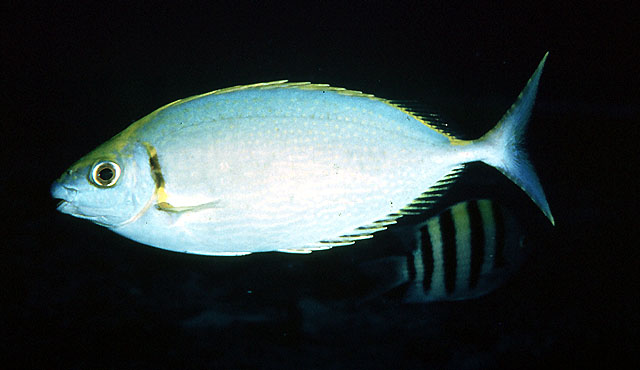| Siganidae (Rabbitfishes) |
| 40 cm TL (male/unsexed) |
|
reef-associated; depth range 0 - 40 m |
| Indo-Pacific: Red Sea and East Africa to Pitcairn. Often the only siganid present on remote islands like Pitcairn, Rapa and Line. |
|
Dorsal spines (total): 13-13; Dorsal soft rays (total): 10-10; Anal spines: 7-7; Anal soft rays: 9-9; Vertebrae: 13-13. Body blue above, silvery below; variations in markings (spots, curved lines) occur. Silvery-yellow iris. When frightened or asleep, entire fish becomes mottled with very light and dark browns, with dark ones predominating in 7 diagonal zones across the sides; fins become mottled. Spines slender, pungent, venomous. Preopercle angle 85°-95°. Fine scales on cheek. Midline of thorax without scales. Superficially resembles S. canaliculatus and S. fuscescens, particularly when young, but differs by having a much more deeply forked tail (Ref. 1602). |
| Inhabits coastal and inner reef slopes and lagoons. Usually occurs in large schools that swim fast and well above the substrate, occasionally all diving down to the bottom to feed (Ref. 48637). Juveniles and adults occur in small schools (2-100) around coral reefs, typically in surge zone at reef edge. Juveniles live near the surface in dense aggregations up to several km offshore, migrating to reef flats just prior to metamorphosis. Feeds on algae (Ref. 30573). Juveniles and adults not frequently found in markets; but prejuveniles form a brief but important fishery when migrating on to the reef flat, e.g. combined catch (with Siganus spinus of 16 tonnes in one season in Guam. Prejuveniles eaten fresh, pickled in brine or made into fish paste (Ref. 9813). Consumed as food although it is known to be occasionally poisonous (Ref. 4537). Used in Chinese medicine (Ref. 12166). |
|
(Ref. 96402)
|
| venomous |
|
Source and more info: www.fishbase.org. For personal, classroom, and other internal use only. Not for publication.
Page created by Jen, 05.08.02,
php script by kbanasihan 06/09/2010 ,
last modified by
dsantos, 20/08/10

